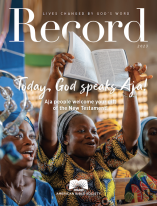How to Pick the Right Reading Plan for Your Group
Taking your time to read through the Bible
I was barely a teenager when I dove into my first one-year Bible reading plan. My text was the Good News Bible—a gift from my father who believed I would enjoy its ease of readability and simple drawings. He was right.
Night after night, I pulled that cream-colored, hardback Bible off my nightstand and laid in bed, reading as much as a 12-year-old boy could without falling to sleep. Genesis was a piece of cake. Exodus was fun, too—full of adventure. Then I stumbled upon the book of Leviticus … and my ambitious one-year plan went down the tubes.
I can’t remember if I got lost in the chapter about scabs and blemishes or the one about lepers. I only know that—at the time—it was all Greek to me.
Thankfully, due to a little prodding from friends and the Holy Spirit, I finally did make it to Revelation, even if it did take a bit longer than 365 days.
I haven’t changed much since my teen years, although I do understand Leviticus better.
Finding the Right Pace
My pace in reading—and in nearly everything in life—always has been methodical. Perhaps that’s why I’ve struggled to get through the Bible in one year. I’ve noticed the same to be true in many churches. Our congregations start out with fresh ambition to read through the Bible in the New Year, but quickly find it hard to maintain. I know I can spend an inordinate amount of time trying to unwrap Scripture’s puzzling passages. Pretty soon, my 120-verse, 30-minute Bible session turns into a 60-minute research-a-thon. And I never make it through the day’s selection.
This doesn’t mean I’m opposed to one-year Bible plans. Reading from Genesis to Revelation in a year can be enriching and rewarding for individuals and churches—and I’ve used such plans several times in my life. But lately, I have discovered the benefits of two-year and three-year plans.
If this is a new concept to you, then perform a quick Internet search. You will find many free resources. Some plans guide the reader through Scripture chronologically, while others give the reader chunks of different books each day. (Mine does the latter. For example, a recent day’s schedule involved text from Isaiah and Matthew.) I pulled my multi-year plan from a smartphone app called A Lamp Unto, but previously used a physical multi-year Bible by Tyndale known simply as The Two Year Bible.
If those you are leading have struggled to make it to the finish line on a one-year Bible plan, then perhaps a multi-year plan would be beneficial. The summer months can be a great time to introduce a fresh new challenge (No, you don’t have to wait until January first!).
Here are four reasons I’ve enjoyed the change of pace:
1. You can go deeper.
Reading over a longer period of time allows you to spend more time studying and meditating on the Bible’s richer texts. After all, most passages deserve more than a quick glance. Take the Sermon on the Mount (Matthew 5-7). And the covenant between God and Abraham (Genesis 15). And Paul’s “love” song (1 Corinthians 13:4-13). Perhaps even Leviticus! There is a reason Jesus compared what he offers to a well that never runs dry (John 4:14). The Bible is rich with meaning, no matter where we turn.
I’ve learned that I get more out of Scripture by spending 30 minutes on 40 verses than the same amount of time on 120 verses. With a good study Bible or a commentary—or just the text and me—I can do that.
2. You can read slower.
Our fast-paced world has its benefits—such as one-minute burritos and two-minute fill-ups at the gas station—but sometimes, it’s helpful to slow down and enjoy the priceless blessings of life.
Thus, at the end of a day juggling work and four children, I’d rather not speed-read Scripture. I want to treat it the same way I would a juicy steak at a fancy restaurant—and savor every bite.
3. You can discover hidden nuggets.
Scripture is like a room full of hidden jewels. The closer you look, the more you’ll find. And if you’re concentrating on a smaller section of the text, you’ll likely discover a bunch of them.
Some of these hidden nuggets are significant (how were people in the Old Testament saved?—read Romans 4), while others fit into the “cool Bible trivia” category (did you know there was a man with 12 fingers and 12 toes?—read 1 Chronicles 20:6).
4. You can catch up easier.
Life doesn’t always go as planned. Perhaps the basement flooded, or the refrigerator went out, or the washing machine stopped working. Or maybe it was something more significant, like a death in the family. Whatever the case, a multi-year Bible plan makes it easier to catch up and get back on track. Once you do, it’ll be easier to stay there.
Of course, any Bible reading plan is beneficial, and one-year plans have their own distinctive advantages. I have yet to meet someone who regrets going through Scripture in 12 months.
But if those you are leading are looking for a new plan or want to try something different in their daily devotionals, then a multi-year plan may be what they need.

Michael Foust
Michael Foust is the husband of an amazing wife named Julie and the father of four small children. He's been a writer for 20-plus years and has covered the intersection of faith and entertainment for more than a decade. Learn more about him at MichaelFoust.com.
Thanks to the support of our faithful financial partners, American Bible Society has been engaging people with the life-changing message of God’s Word for more than 200 years.
Help us share God's Word where needed most.
Connect with our Bible engagement blog for leaders and receive a Bible-reading Habit Guide for your community.









